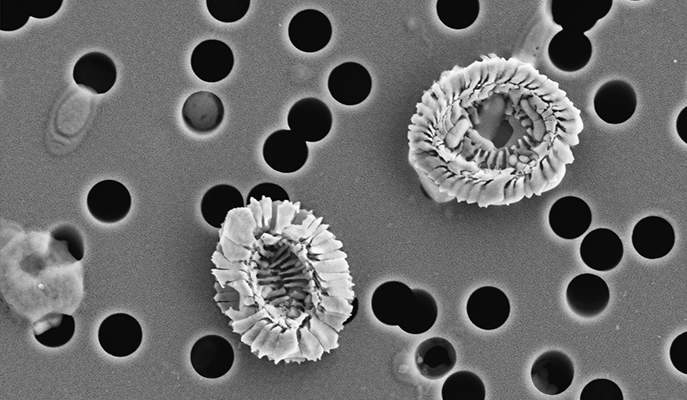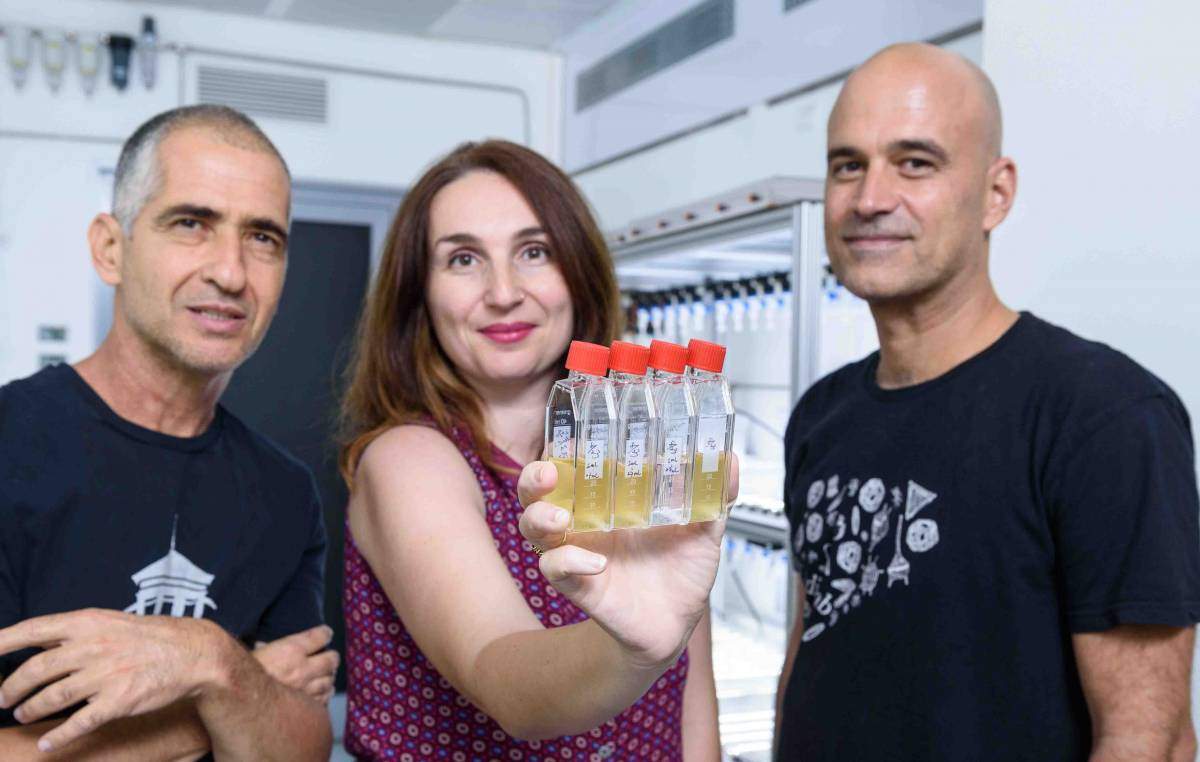When viral infection wipes out an algal bloom, fragments may turn airborne, increasing clouds and cooling the surface below

Fragments removed from filters in the air above water in which phytotplankton died from viral infection. Sizes range up to four microns
When microscopic plankton in the oceans catch a virus, the forecast might be rain. New research at the Weizmann Institute of Science finds that as plankton die off from viral infection, some of the bits and pieces they leave behind are released into the atmosphere, where they can affect cloud formation and reduce the sun’s glare. This research, which suggests the effect may be a significant factor in the planetary fluxes of energy and gases, was recently reported in iScience.
Weizmann Institute researchers – Profs. Ilan Koren and Yinon Rudich, and Dr. Miri Trainic of the Earth and Planetary Sciences Department, and Prof. Assaf Vardi of the Plant and Environmental Sciences Department – have been investigating a type of phytoplankton known as Emiliania huxleyi that is responsible for giant algal blooms that spread rapidly on the ocean’s surface and suddenly disappear after a few weeks. In previous research, Vardi and his group showed that the massive die-offs that put an end to the blooms are caused by a virus that is specific to these organisms, and – together with Koren – they had explored the way that viruses travel quickly across a bloom on the ocean breezes. In the current research, the group asked whether the phytoplankton – or at least the bits that are left after the virus has destroyed them – might also travel by air.
As plankton die off from viral infection, some of the bits and pieces they leave behind are released into the atmosphere
Emiliania huxleyi belongs to a group of phytoplankton called coccolithophores that cover themselves with lacy shells, named coccoliths, made of calcium carbonate. When the plankton die from the viral infection, many of their shells sink to the ocean floor; but the research group suspected that some of their remains get thrown up into the atmosphere along with salt and other particles, collectively known as sea spray aerosols. These particles are flung upwards from bubbles on the ocean’s surface that burst open. In the atmosphere, such aerosols help reflect sunlight away from the Earth’s surface, and they form nuclei around which cloud droplets condense.
The phytoplankton contribution
The first step in understanding how phytoplankton contribute to this process was to grow them in the lab. Trainic and the team raised the plankton in the lab in large containers of sterilized seawater and infected them with the virus a week later. After the infection was under way, the researchers introduced bubbles into the water and filtered the air above the water to collect the airborne particles. These were placed under an electron microscope for analysis.

Prof. Ilan Koren, Dr. Miri Trainic and Prof. Assaf Vardi are uncovering the connection between algal die-offs and cloud formation
The number of phytoplankton particles the team counted was much higher than they had anticipated, and the size range of the particles, themselves, was also quite a bit larger than predicted. Rather than one micron or less, they found fragments ranging up to four microns. This was apparently due to the pieces of phytoplankton shell having a low density, which makes even the larger particles well suited to flight. “Some are shaped like parachutes or hollow ellipses,” says Vardi. “They have an intricate structure of calcium carbonate with lots of internal space, which extends the particle’s lifetime in the atmosphere.” The group calculated that these would settle about 25 times more slowly than the denser sea salt particles found in aerosols.
During a summer research trip to Norway’s fjords, Vardi and his team collected samples of the water there in huge bags that enabled them to monitor not only the living organisms in the water but the aerosols they produce. The group plans to use these to begin examining the natural cycles of plankton content in the atmosphere above the oceans. Because phytoplankton blooms tend to be much heavier near coasts than out in the open ocean, they believe that the atmospheric effects of the die-offs may be felt there most strongly.
The state of the atmosphere greatly depends on the daily interactions between microorganisms, viruses and bacteria in seawater
“Particles of materials like calcium carbonate can be surfaces for atmospheric chemical reactions, and they could significantly contribute to the Earth’s radiation budget because they are very reflective, redirecting solar radiation upwards,” says Koren.
“While this study focused on one species and its virus, we now see that, in a broader context, the state of the atmosphere greatly depends on the daily interactions between microorganisms, viruses and bacteria in seawater,” says Trainic.
Prof. Ilan Koren’s research is supported by the Sussman Family Center for the Study of Environmental Sciences; the Bernard and Norton Wolf Family Foundation; and Scott Jordan and Gina Valdez.
Prof. Assaf Vardi’s research is supported by the de Botton Center for Marine Science; the Edmond de Rothschild Foundations; the Bernard and Norton Wolf Family Foundation; Scott Jordan and Gina Valdez; the David and Fela Shapell Family Foundation INCPM Fund for Preclinical Studies; and the European Research Council.
Prof. Yinon Rudich’s research is supproted by the Dr. Scholl Center for Water and Climate, which he heads; the Sussman Family Center for the Study of Environmental Sciences, which he heads; the Ilse Katz Institute for Material Sciences and Magnetic Resonance Research; the de Botton Center for Marine Science; Dana and Yossie Hollander; Paul and Tina Gardner; the estate of Fannie Sherr; and the estate of David Levinson.

Recent Comments